|
First Battle of Saltville
Saltville Civil War History
| Battle of Saltville |
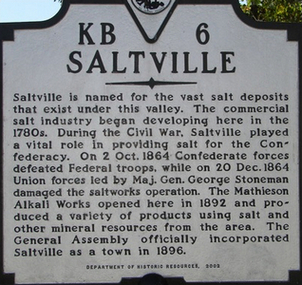
|
| First Battle of Saltville |
First Battle of Saltville
Other Names: Battle of Saltville; First Battle of the Saltworks;
Battle of Cedar Branch
Location: Smyth County, Virginia
Campaigns: Burbridge’s Raid into Southwest Virginia (September-October
1864); Virginia Saltworks Campaign (May-December 1864)
Date(s): October 2, 1864
Principal Commanders: Brevet Maj. Gen. Stephen Burbridge
[US]; Brig. Gen. Alfred E. Jackson [CS]
Forces Engaged: 8,000 (US 5,200; CS 2800)
Estimated Casualties: 448 (US 348; CS 100)
Result(s): Confederate victory
Summary: The First Battle of Saltville was fought during the
Saltworks Campaign and was the third of five Union attempts to destroy the salt capitol of the Confederacy. In an attempt
to destroy the salt production near Saltville, Virginia, Brevet Maj. Gen. Stephen Burbridge led an army of 5,200 strong.
In this six hour fight, 11 a.m. to 5 p.m., Union cavalry, including one of only six regiments of U.S. colored
cavalry raised during the war, would dismount and engage a well-entrenched Confederate force only to be repulsed from
the field. Brig. Gen. John Echols, commanding Confederate
forces at Saltville, would masterfully employ a series of delaying actions against two large Union armies, Burbridge
and Gillem, in a successful attempt to buy time and add the much needed reinforcements to his patchwork command of 400.
Burbridge was delayed at Clinch Mountain and Laurel Gap by a small Confederate
contingent, enabling Brig. Gen. Alfred E. Jackson to concentrate troops near Saltville to engage. On the morning of October
2, 1864, the Federals attacked but made little headway as Confederate reinforcements continued to arrive during
the day. After day-long fighting and after suffering heavy losses on their left, the Federals would dig in on the side
of a steep slope. Having committed a series of frontal assaults up the rugged terrain, and with ammunition now exhausted, Burbridge retreated early on the 3rd without accomplishing his objective, but as he was retiring
in what rapidly turned into a disorderly retreat, his rear units were struck by Confederate forces. During the hasty
withdrawal, Burbridge abandoned his wounded, the majority being colored troops, and Confederate soldiers under orders
from Brig. Gen. Felix Robertson, summarily murdered the captured and wounded black soldiers and white officers. The action
quickly became known as the Saltville Massacre.
| Civil War Battle of Saltville Map |
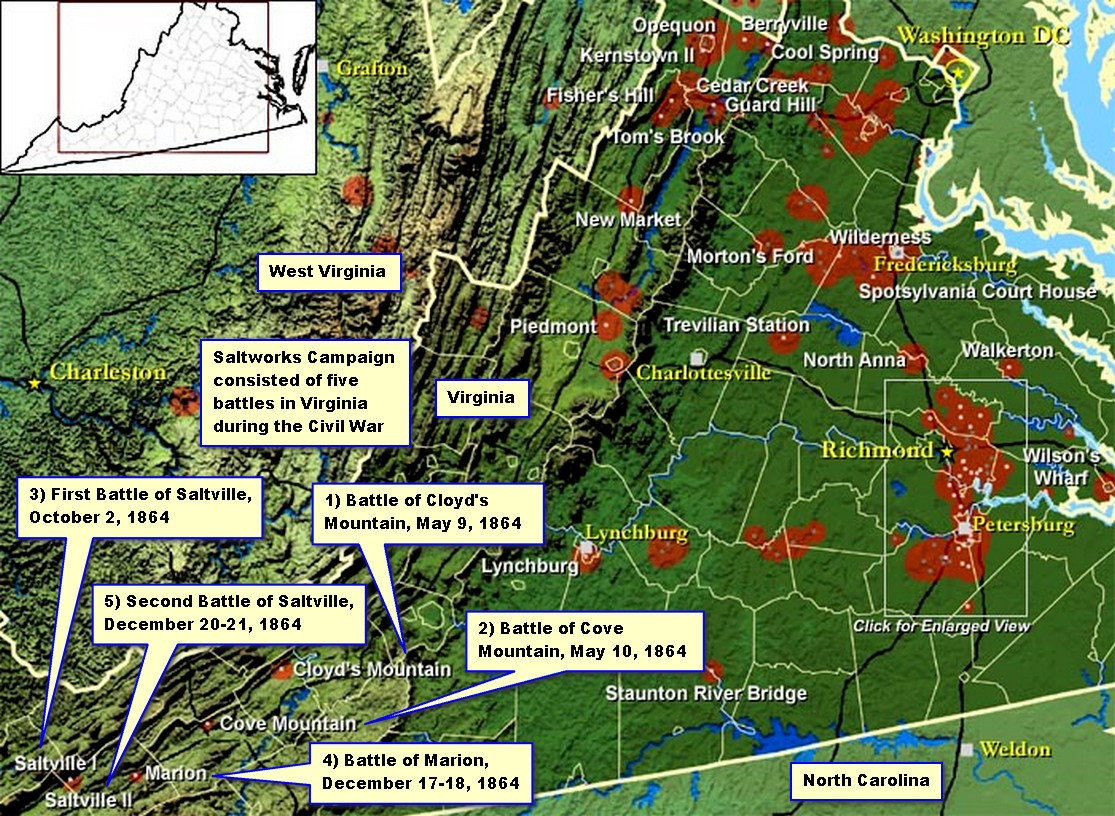
|
| Battle of Saltville Map |
| Southwestern Virginia and the Civil War |
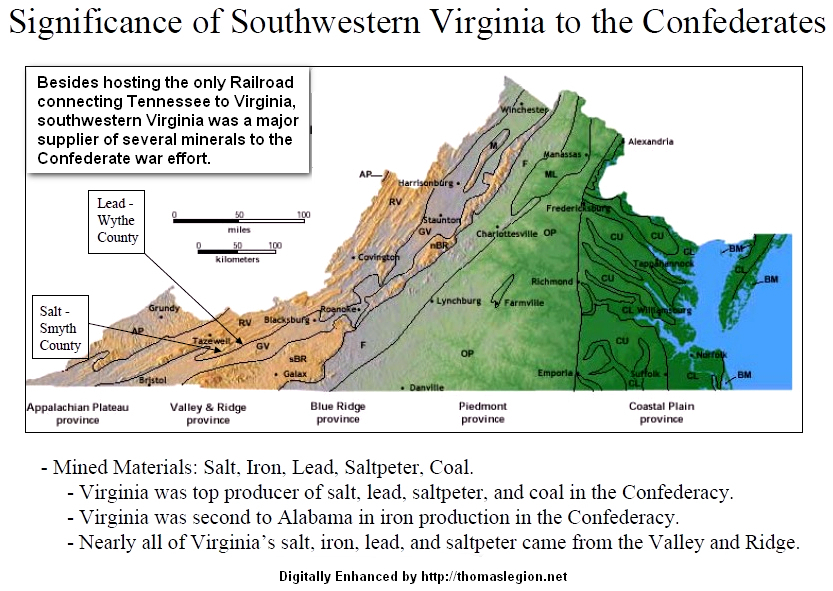
|
| Southwestern Virginia was vital to the Southern war effort |
Introduction: This contest was a microcosm of the
Brothers' War, for opposing sides had recruited from some of the same counties in Kentucky, and this action involved colored
cavalry, West Point and VMI graduates, and the highest ranking official to ever commit treason against the United States.
The youngest vice president in history, John C. Breckinridge, also cousin to Mary Todd Lincoln, was a Kentuckian who took up arms
as a Confederate general, and Union Gen. George Crook, who would later become a controversial figure during the Indian
wars, was roommate to none other than "Stonewall" Jackson while attending West Point. "Stonewall" would meet his fate
by friendly fire at the Battle of Chancellorsville in 1863, but Crook would rise through the ranks to the permanent grade
of major general, and President Grover Cleveland would appoint him commander of the "Military Division of the Missouri" in
1888. This was indeed Civil War.
Southwestern Virginia was important to the Confederacy though it experienced
few battles. The Virginia and Tennessee Railroad ran through the region, connecting the eastern and western theaters
of operation. It also hosted salt and lead mines that were vital to the Southern war effort. Located in northwestern
Smyth County, Virginia, Saltville, during its peak war year in 1864, manufactured about 4,000,000 bushels — 200,000,000
pounds — an estimated two-thirds of all the salt required by the Confederacy. No wonder, then, that this remote area
found itself in the 1860s thrust into the very center of military activity in southwestern Virginia as North and South clashed
over these vital salt operations. Salt was necessary for preserving food, for sustaining life itself, and it was an integral
part of the leather curing process. An army may march and fight well on a full stomach, but without leather it
would have to do it with the poorest quality boots and footwear, and absent leather there would be no saddles and the
much needed tack for horses.
In September 1864, Union Brig.
Gen. Alvan Gillem planned a raid from his base in East Tennessee, and he requested the assistance of Brevet Maj. Gen. Stephen
Burbridge, commanding District of Kentucky. Burbridge thwarted Gillem’s plan by requesting permission from Union
Army Chief of Staff General Henry Halleck to launch an expedition toward Saltville from Kentucky while Gillem threatened the
area from the southeast. Although Burbridge would be repulsed in his attempt to strip the Confederacy of its much needed salt, Gen.
George Stoneman would be successful just a few months later in December.
| Battle of Saltville Map |
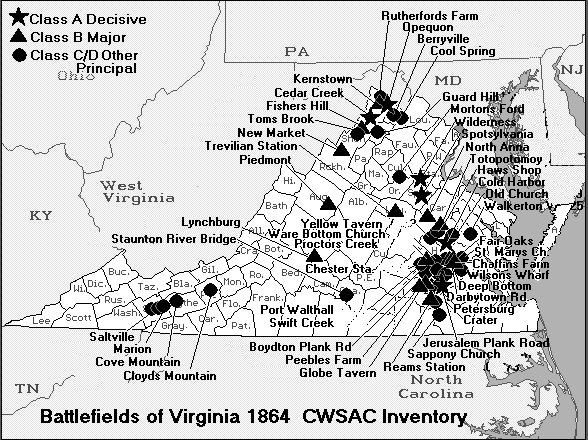
|
| Saltville Civil War Battlefield Map |
Background: The First Battle of Saltville, October
2, 1864, was the third of five attempts to destroy what was referred to as the salt capitol of the Confederacy. This engagement was fought mainly with Kentucky men. While the Union would employ all cavalry
and mounted units, the Confederates would throw every available unit, from militia to regular, into the fray. With the
exception of the 11th Michigan and 12th Ohio Cavalries, the Union command
was formed of Kentucky units, while the Confederate forces were of Kentucky, Virginia, Georgia, and Tennessee.
Stationed at Point Burnside,
Kentucky, the IV Brigade, consisting of the 11th Michigan and 12th Ohio, was to assist in the expected fight against
Maj. Gen. Joe Wheeler, but the brigade was reassigned to Burbridge for the Saltville raid. The 5th United States Colored Cavalry, one of only six colored cavalry units
formed during the war, was being formed at Camp Nelson, in the Bluegrass State, when Colonel James S. Brisbin, commanding,
agreed with Brevet Maj. Gen. Stephen G. Burbridge's request to prematurely press the green recruits into service. The
5th USCC was then placed under command of Colonel James F. Wade, who would later command the 6th USCC, and attached to
the IV Brigade for the Virginia incursion.
Although Kentucky, a Border State during the war, had declared its
neutrality once hostilities began, the several thousand Kentucky men in blue who were trekking through southwestern
Virginia were determined to crush the Rebellion at every turn and town.
By late September, Union Bvt.
Maj. Gen. Stephen G. Burbridge, the widely despised military governor of Kentucky, decided to move on Saltville. On September 20, Burbridge left Kentucky with some 5,200 strong, including 600
of the 5th U.S. Colored Cavalry. In East Tennessee, Brig. Gen. Alvan Gillem commanded a Union army of 1,650, while Brig.
Gen. Jacob Ammen led a force of 800, and on Sept. 28, the combined command, numbering 2,450, continued
to move through the region while fighting the enemy. The two brigadiers had planned to move on the Confederates
at Saltville in an 1800s pincer style movement with Burbridge, but because Gillem and Ammen would become involved
in a series of skirmishes in the Tennessee mountains, the force would not be present for the engagement but would
serve as a diversion.
Burbridge chose a particularly difficult invasion route into southwestern
Virginia, moving along the Levisa Fork of the Big Sandy River through the rugged, deeply dissected plateaus country. The Federals
moved over an especially rugged mountain on September 28 at night during a thunderstorm. Perhaps as many as eight men and
their mounts fell to their deaths from the precipitous trail. Others had to be rescued with ropes.
Meanwhile, on the Confederate
side, Saltville's defense was the responsibility of the newly reorganized Department of Southwest Virginia and East
Tennessee. The Department's commander, Maj. Gen. John C. Breckinridge, like opposing commander Burbridge, a Kentuckian,
had been campaigning in the Shenandoah Valley under Lt. Gen. Jubal Early but was hastening back to southwestern Virginia
to confront the Union advance. For less than one month, Brig. Gen. John Echols, a VMI graduate, had been acting commander
during Breckinridge's absence. As 5,200 strong were slowly trekking southward, the patchwork
force that awaited them numbered 400. During September, Echols sent dispatches throughout the region requesting units to
come to his aid, and while he personally rode to nearby towns rallying every
available man for the defense of the city of salt, he temporarily placed Brig. Gen. Alfred E. Jackson in command.
To counter the large Federal army moving in his direction, as reported
by scouts, a series of delaying actions were put into motion by Brig. Gen. John Echols.
While Echols was commanding Confederate forces at Saltville
in September 1864, he received dispatches indicating that Union Bvt. Maj. Gen. Burbridge had departed Lexington, Kentucky,
and was en route to Saltville, with orders to destroy it. Several reports placed the Federal force at
6,000 to 8,000 strong, numbers that were more than troubling to Echols, who commanded a battalion sized force of 400
men at Saltville, which was scarcely enough to check the Federal advance. But the situation was more dire, because Brig. Gen.
Gillem was in East Tennessee and his intention was to advance his army on and lay waste to the prized
saltworks. Echols needed men, he needed reinforcements immediately. Victorious, "Stonewall" Jackson was often confronted
with two or more much larger armies during the 1862 Valley Campaign, and he would rapidly strike and cripple one army
before moving and attacking the next force. Straight from "Stonewall's" playbook, Echols sent some 300 cavalry to
Bull's Gap, TN, to punish and harass the enemy. All available units, meanwhile, were ordered to report to Echols
at Saltville. Maj. Gen. Breckinridge, who had been fighting in the Shenandoah Valley
under Lt. Gen. Early, was returning to his old command at Saltville. Confederate Brig. Gen. Johns S. Williams also
responded from Bristol, TN, and was moving his vanguard force of 1,700 soldiers
into southwestern VA, while 300 Virginia reserves, under Lieutenant Colonel Preston, were en route by train.
George
D. Mosgrove, a Kentucky Confederate soldier, described Saltville as a “natural fortress” with hills and ridges
in concentric circles, which greatly aided in the Confederate defenses. His account of the battle of Saltville
begins in the summer of 1864, when rumors circulated that Bvt. Maj. Gen. Stephen Burbridge’s forces were marching
toward the saltworks on a parallel course with the Confederate forces under Brig. Gen. John Hunt Morgan. In late
September, closer to the time of the actual battle, Mosgrove writes that scouts reported a force of 6,000 to 8,000
cavalry with six to ten pieces of artillery coming from Kentucky, commanded by Gen.
Burbridge, Gen. E.H. Hobson, and Colonel Charles Hanson. In addition, the scouts reported seeing two possible African-American
brigades, which were in fact the 5th and the beginnings of the 6th United States Colored Cavalry (USCC). Gen. Basil Duke,
a member of Morgan’s army, also presents an account of the battle of Saltville. He notes that in addition to the threat
presented by Burbridge, two other Union generals, Jacob Ammen and A. C. Gillem, were advancing toward Saltville,
but were coming from Knoxville, Tennessee, as opposed to the Kentucky route Burbridge was taking.
In response to the scout's report, Confederate Colonel Henry Giltner sent
Colonel Edward Trimble with 150 men to Richlands, 40 miles from Saltville, to head off the Union forces. Colonel Trimble then
instructed Giltner to take 100 of his men to the gap in Paint Lick Mountain to protect the main turnpike road running
through that gap, and to provide reinforcements should Trimble need to fall back. Burbridge sent a battalion to Jeffersonville
(present-day Tazewell), on the Confederate right, to try another approach toward the saltworks. Giltner then sent Captain
Bart Jenkins with an additional company to meet the Union forces at Jeffersonville. Trimble did skirmish with Federal forces
at Cedar Bluff and was forced to fall back. The consolidated Confederate force of 300 men, under Giltner, was then pushed
back to the summit of Clinch Mountain, and attempted to hold that mountain pass into the valley. The Union army sent 500 men
around Paint Lick Mountain toward Jeffersonville, flanking the gap.
| Saltville Civil War History |
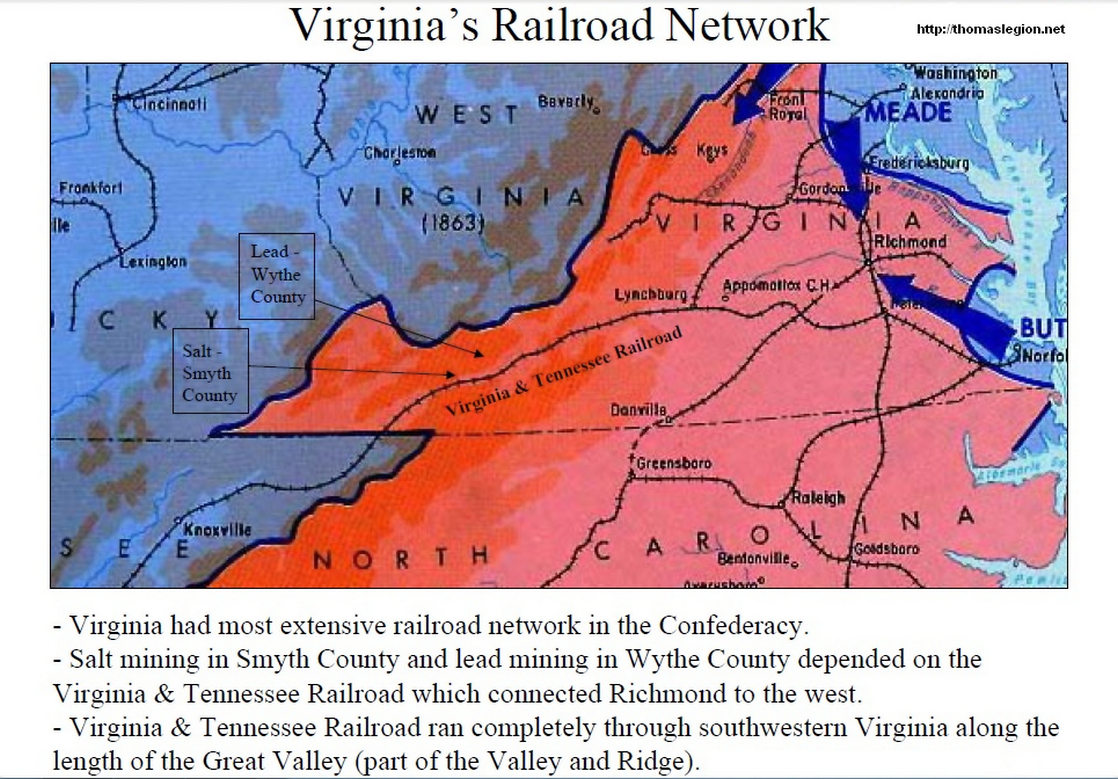
|
| Battle of Saltville |
| Principal Events of Union Army |
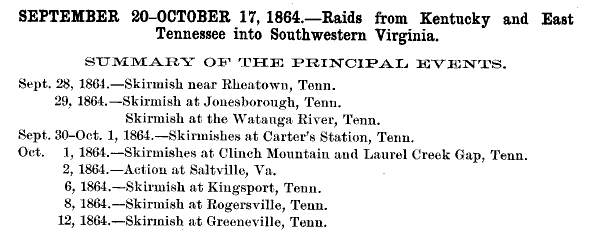
|
| Events Surrounding Battle of Saltville |
Battle: The
battle would open on October 2nd with Bvt. Maj. Gen. Stephen Burbridge committing the greater portion of his force,
but Confederate resistance was strong, much stronger than the Union general anticipated, so in what would quickly unravel
into a disjoined assault he soon threw the bulk of his reserves into the fray. Some 4,000 Federals, the greater
part of his 5,200 strong command, including 400 colored cavalry, would engage in the action.
Of note was the unproven 5th
United States Colored Cavalry that was being formed at Camp Nelson, Kentucky, when it was pressed into service. The recruits of the 5th, mainly
ex-slaves, would receive their baptism of fire and perform like seasoned veterans as more than 100 fell while charging
Confederate works, but it would be three weeks after the battle, Oct. 24, 1864, that the 5th would officially
become a unit. En route from Kentucky, the colored soldiers, as well as
their white officers had been the subject of much ridicule and many insulting remarks by white Union troops of the command.
Colored soldiers will not fight were among the jeers and taunts, but though recipients of such remarks they refused to
hurl insults in return.
Burbridge had eagerly moved the raw recruits of the forming 5th into
Virginia, but knowing that the colored troops lacked the necessary training for combat, the Union commander also
bestowed upon these soldiers what was considered substandard equipment for 1864 cavalrymen, thus promulgating an environment
ripe for the bloodbath to come.
Whereas the white Union cavalry and mounted units of the division were
atop proven chargers and armed with 7-shot Spencer carbines (some had the Ballard or Starr carbine) and one or more
revolvers, the unproven black troops were riding untested mounts, which were intended for the purpose of drilling only, and
armed with outdated single-shot, muzzle-loading Enfields.
Of the 600 men forming the 5th USCC, 100 were left behind sick, 100 remained in the valley to hold the horses, leaving
400 effectives for this fight. And of the 350 Union soldiers who fell at Saltville,
the 5th USCC suffered 33% of the total Federal losses. While fighting dismounted on the Federal left, the 5th sustained
28% casualties, during this single action, which would be the highest loss suffered by any Union unit in the action
at Saltville. I have seen white troops fight in 27 battles, Brisbin later reported, and I never saw any fight better.
Burbridge marched his command across the mountains, into southwestern VA, where he met and fought small Confederate units from Sept.
30 to Oct. 1, when his tired command arrived at Laurel Gap, some 4 miles from Saltville. Camping for the night, Burbridge wanted
a well-rested force for the assault on Saltville in the morning. Whereas only 400 Southern soldiers were in position
to defend the works on the evening of Oct. 1, Brig. Gen. Williams would arrive with his force early on Oct. 2, and ready for
action. Soldiers indeed responded to the many pleas from Echols, and while the fight raged, troops would continue to
stream onto the battlefield, thus swelling the size of the Confederate army to some 2,800. If Burbridge would have opened
the battle on Oct. 1, his 5,200 strong would have easily brushed aside the small Confederate force of 400.
| Battle of Saltville Civil War History |

|
| Confederate units were informed to hold Saltville at all hazards |
| Map of Union and Confederate Armies at Saltville |
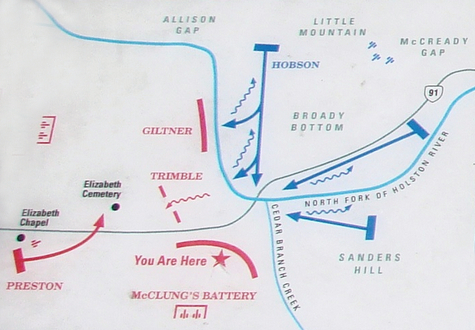
|
| Map of First Saltville Battlefield on October 2, 1864 |
On the evening
of September 30th, Captain Edward Guerrant made his headquarters at the home of George Gillespie, near the grounds of Gen.
Bowen. Late at night, the captain was awakened with news that the Union forces were firing on Gen. Bowen’s property.
Captain Guerrant responded by sending a member of the 10th Kentucky Cavalry to warn Colonel Giltner, and by sending
the 4th Kentucky Cavalry to picket toward the Union. That same day, Lt. Col. Robert
Preston also arrived in Saltville with his reserves. He was unaware of the strength of the Union forces approaching the town;
his orders had simply been to reach Saltville as quickly as possible, according to the account of one of his reservists and
friends.
As Burbridge approached Saltville on October 1, Breckinridge's chief
lieutenant, Brig. Gen. John Echols, was calm while quickly pulling together scattered forces for the defense of the saltworks.
In Saltville itself, command fell to Brig. Gen. Alfred E. Jackson, derisively
called "Mudwall" by his own men, a sobriquet he apparently earned by his ineptness. But "Mudwall," to his credit, prepared
Saltville's defenses well, constructing fortifications and rifle pits, and when the Yankees finally attacked, they
found the rebel soldiers firmly entrenched on the hills north and west of town.
A. E. Jackson, a Tennessean, was a farmer who owned 20 slaves prior
to hostilities. Jackson lacked any military service, and unlike the grads of
VMI and West Point, he had no formal training. As a brigade commander, his inexperience was a contributing factor to poor
morale in the ranks, causing from simple complaints to desertion. Whereas it was common practice to openly punish and
discipline slaves, Jackson would publicly rebuke officers in the presence of enlisted men, which was considered
a forbidden practice. He is often confused with William Lowther "Mudwall" Jackson Jr., a Confederate general and second cousin
to "Stonewall" Jackson.
On October 1st, the evening before the battle, the Federal soldiers camped on the grounds of Gen. Bowen,
two miles outside of the Confederate position within Saltville. At that time, only the Virginia reserves were actually stationed
within the town, with but a few pieces of artillery. Brig. Gen. John S. Williams was collecting as many men as possible
at Castle Woods, not far from Saltville, and while Brig. Gen. Echols was rounding up soldiers from nearby Abington, Brig, Gen. Alfred Jackson arrived at Saltville and supervised the fortifications under construction.
The 64th Virginia Battalion, under Lieutenant Colonel Robert Smith with
250 men, and the 10th Kentucky Cavalry were both on the summit of Flat Top Mountain, guarding possible entrances to Saltville.
Following a skirmish with Federal troops, the regiments were forced to fall back to Laurel Gap. In addition, the 4th and 10th
Kentucky Mounted Rifles were already posted at Laurel Gap. Laurel Gap is surrounded on either side by tall cliffs, thought
to be inaccessible, and not to be scaled. However, the mounted rifles were posted as far up the left cliff as possible, and
the 64th battalion was stationed on the right. Colonel Trimble was also sent up behind the mountain with his battalion. Late
in the afternoon, Union forces secured passage through the mountain by pushing the 64th Battalion from its position and crossing
on the right. The remaining Confederate forces then retreated to Saltville. At Broadford the road into the town forked and
split into two separate roads, both leading southward into the valley toward Saltville. Giltner took the 64th Virginia
and the 10th Kentucky Mounted Rifles across the Holston River, and ordered Trimble to take the 4th and 10th Kentucky Cavalry
down the main river road, thus covering both avenues of approach. By midnight, the entire Federal force was able to cross
the mountain through Laurel Gap.
The battle opened on the cold morning of October 2nd with the Federals attacking pickets
and skirmish lines. The 4th and 10th Kentucky Cavalry under Colonel Trimble then crossed over to ground occupied by Colonel
Giltner to act as reinforcements. Colonel Trimble’s men then attacked the Union forces, and fell back slowly. Meanwhile,
the Union forces charged the 4th Kentucky Cavalry and skirmished with them for half an hour. Part of the 4th occupied a position
high on the hill near “Governor” Sanders’ house, where a contingent of 250 men, that had arrived in
advance of Brig. Gen. John Williams' main body to reinforce the Confederates, had moved onto the field under
Gen. Felix Roberston, who had just arrived himself with detachments of the 8th and 11th Texas Cavalry. Notorious Confederate guerrilla Champ Ferguson and several of his guerrillas also arrived
with Robertson.
| Union Approach Up Cedar Branch |
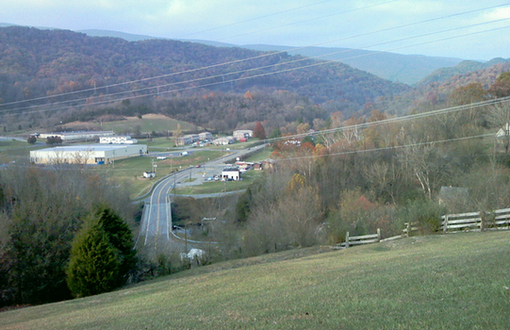
|
| View of Union approach up steep embankment at Battle of Saltville |
At this point, Mosgrove’s account lists fighting and changing of positions,
with a bit of confusion as to which regiment was moving where. Ultimately, the Confederate forces ended up positioned all
along the ridges. Gen. Williams was on the high ridge near Sanders’ hill, and Giltner was pushed back to the bluffs
along the Holston River. The 10th KY Cavalry was on the bluff at the ford, with the 10th KY Mounted Rifles to their left.
The 64th VA Reserves were then to the left of that regiment, and the 4th KY was to the left of them. Finally, on the extreme
end of the line was Lt. Col. Preston’s 300 reserves. Another battalion of reserves under Lt. Col. Smith and
Major John S. Prather were barricaded around Governor Sanders' home. The Federal forces advanced on the Confederate line.
At midmorning, the Union forces formed into three columns and attacked the reserves surrounding Sanders’ house. The
13th Battalion of Virginia Reserves stationed at the house fought, but the Union forces were able to push them back to Chestnut
Ridge. The Union troops stormed the yard, and followed the reserves up Chestnut Ridge, where they were met by the Confederate
brigades of Gen. Robertson and Colonel George Dibrell.
The three Union columns then moved to attack Trimble’s position at
the ford. One column went directly down Sanders’ hill, another moved along the river, and one swept across the wide
bottom of the hill. The Federal forces crossed the ford, scaled the opposite cliff and attacked Trimble’s position.
In response, the 10th Kentucky Mounted rifles and the 64th Virginia were sent to support Trimble. Giltner went to the reserves
barricaded in trenches at the nearby church and moved them down the road and up by Elizabeth Cemetery to support Trimble.
Trimble fell back, and the colonel himself was killed. The Federal column
led by Colonel Hanson was on the far left side of the mountain. His brigade eventually met up with the 4th Kentucky and Preston’s
reserves.
The Union forces were then repulsed on all sides, and the colored contingent
was severely crippled after it made a series of determined charges against the Confederate right. Unlike the white Union
units sporting Spencer carbines, capable of firing 7 shots from a tube and enjoying a sustained
rate-of-fire of 21 rounds per minute, the black soldiers were given single-shot, muzzle-loading Enfields, which, upon being discharged
while on the exposed embankment, were absolutely worthless.
Burbridge, becoming more frustrated with the lack of progress,
decided an all or nothing gamble by pushing his entire IV Brigade against the stubborn Confederate right. Having
nearly exhausted their ammunition, the 5th US Colored Cavalry, consisting of 400 recruits, with the 11th Michigan and
12th Ohio cavalries, under the brigade commander, Col. Robert W. Ratliff, began their steady ascent up the steep
terrain while enemy fire poured down into their exposed position. The raw recruits of the 5th, with their Enfields, had
made two heroic charges up the mountainside toward Chestnut Ridge, only to be raked by grape and canister shot
and then crash into Confederate musketry and be driven back with heavy losses.
The Spencer carbine, a shorter version of the Spencer repeating rifle, was a manually operated
lever-action, repeating rifle fed from a tube magazine that held seven cartridges, which allowed the experienced horseman
a rate of fire of 14 to 21 rounds per minute. The Enfield was designed to fire while in line, in formation, not for charging
up the side of a mountain while the enemy is entrenched on good ground pouring hot lead at you. The Spencer
carbine was an outstanding firearm, enabling merely a handful of soldiers the capability of unleashing hell at the enemy.
It was also designed for cavalrymen, allowing the 7-round tube to be exchanged for a loaded one for rapid firing while
on horseback. On a mountain side, the carbine was king.
The 5th resembled a slow wave
rolling across the terrain as it made the third and final attempt to take the Confederate works on Chestnut
Ridge. With colored troops now falling dead and wounded from enemy small arms fire, the soldiers, waiting patiently
to fire their single-shot weapons, continued to press slowly toward the objective and upon discharging their Enfields
at some 50 yards distance from the well-entrenched Rebel works, the fighting 5th let out a shout and rushed
forward. They struggled to move up the steep incline and into the Confederate outer works, consisting of rifle pits with head
logs, where they engaged in some hotly contested hand-to-hand combat, and with sheer numbers they overran the works
and pushed the enemy toward the ridge. But without ammunition and any reserves to reinforce their move, they were forced back
with many of them left wounded and dying on the field. Having pulled back to the outer
trench, the bloodied 5th readied itself for what it believed would be an imminent countercharge — only it would never
occur. Ratliff’s Brigade was running perilously low on ammunition and was cut off from the rest of Burbridge’s
forces and their supply line.
Active firing ceased around 5 in the evening, and at that point the
Confederates were able to hold the mountain pass at Hayter’s Gap, which was the most direct route out of Saltville.
The Union troops continued to hold their position one mile out of Saltville until
nightfall. Generals John Breckinridge and John Echols arrived after nightfall, with the small brigades of Generals Basil
Duke, George Cosby and John C. Vaughn. According to the memoirs of Gen. Duke, Vaughn was left at Carter’s Station,
Tennessee, while Cosby and he were ordered by Echols to head on to Bristol, TN., on September 30th. However,
the following day, they received word from Gen. Echols that they were to head to Saltville, and arrived shortly after their
own brigades. With the “fresh” brigades, the Confederates were reinforced, and intended upon resuming the offensive
in the morning.
Col. Brisbin reported moving 400 of
the 5th USCC into action, a number that Mosgrove later noted as participating in the fight during that day. That evening,
Gen. Dibrell told Mosgrove that his men had fought 2500 Yankees during the battle, and had taken down 200 of those men. After
dark, Captain Guerrant and Mosgrove also met up with Gen. Robertson, who claimed that his men had, “killed nearly all
the negroes.” His claim was inaccurate of course, but with scores of colored troops strewn across the field on
the Confederate right, he may have initially thought that the entire 5th had indeed been nearly wiped out. At the close
of the evening, the 4th Kentucky relieved Trimble’s battalion of guarding the ford between the Confederate and Union
camps.
| Map of Virginia Civil War Battles in 1864 |
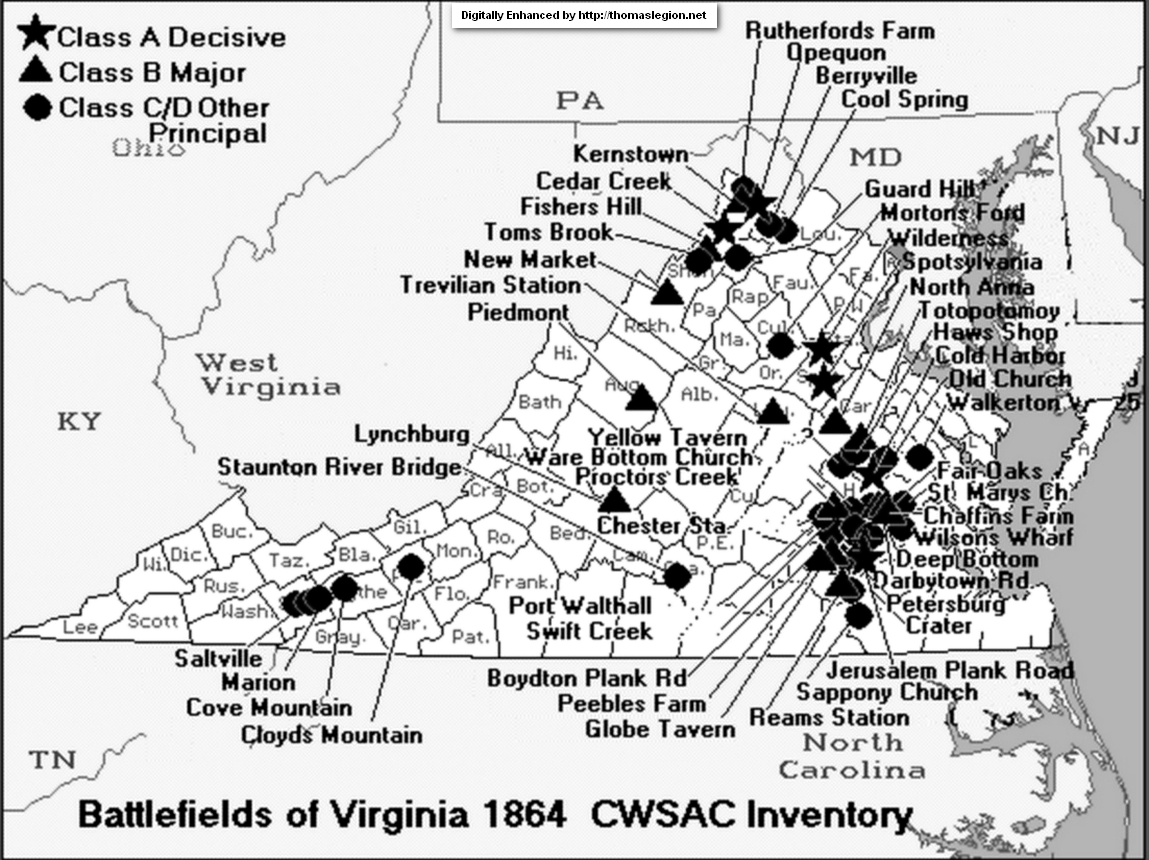
|
| (Map) Battle of Saltville, Virginia |
Retreat: Monday, October 3rd began with a Federal
retreat ordered by Burbridge early in the morning, still during the dark, but it was not the kind of withdrawal the Union
commander would report to headquarters on Oct. 7th: "In the evening our ammunition gave
out, and holding the position taken until night, I withdrew the command in excellent order and spirits."
It was nothing short of a rout with the Federals retreating in confusion
and abandoning from carbines to more than 100 wounded left for dead. The murdering of any reportable number of black troops
and white officers could only occur if the Union army left them during a hasty
retreat. So contrary to Burbridge writing in his official report that it was an orderly and excellent withdrawal, it
was every man for himself during the exodus of Saltville. Ammunition was exhausted, the Union army had pressed itself into a
grinder, Confederate reinforcements had arrived, and Burbridge left under the
cover of darkness to save his weary command from further disaster. While the defeat at Saltville was due to the poor
planning and tactics of Burbridge, it was the chaotic retreat that would force the battle of salt into public spotlight. Instead
of eyeing Burbridge for the debacle, Northerners would demand vengeance on those who had committed the murders of the
defenseless black and white men on that day.
We whipped the enemy badly here, recorded
Confederate Brig. Gen. John S. Williams on the activity at Saltville, and the Yankees retired in confusion, leaving their
dead and wounded in our hands. Their negro troops were also cut up, continued Williams.
The Union troops abandoned their position
without taking much of their equipment, and even leaving many of the wounded behind on the field in order to gain ground
on the expected Confederate pursuit. As the morning sun strained to pierce the foggy and smoke filled sky looming over the
battlefield, Gen. Breckinridge ordered a scout to locate the Union forces. Captain R.O. Gaithright was sent to pursue
the Federals from the rear, while Gen. Williams was sent with the brigades of Duke, Cosby and Vaughn down through Hayter’s
Gap to intercept the Union at Richlands. Colonel Giltner’s brigade was also sent in pursuit of the Union troops, but
was instructed not to follow too close to allow Gen. Williams enough time to advance beyond the Union movements.
Evidence of the Federal retreat was seen all along the route toward Laurel
Gap. Captain Gaithright eventually caught up with some of the African-American troops near Laurel Gap. Late in the afternoon,
Captain Gaithright also spotted the rear of the Federal column crossing Clinch Mountain. By dusk, Colonel George Diamond with
the 10th Kentucky cavalry attacked the Federal rear while crossing the Clinch River. Duke wrote that he and Gen. Cosby
did overtake Burbridge at Hayter’s Gap; however, mistakes in reconnaissance and other tactical errors allowed the Union
escape. Thus, by noon the following day, it became obvious that Gen. Williams had been unable to head off the Union retreat,
due to their head start. The pursuit therefore ended and the first battle for Saltville was over.
| Battle of Saltville, Virginia, Map |
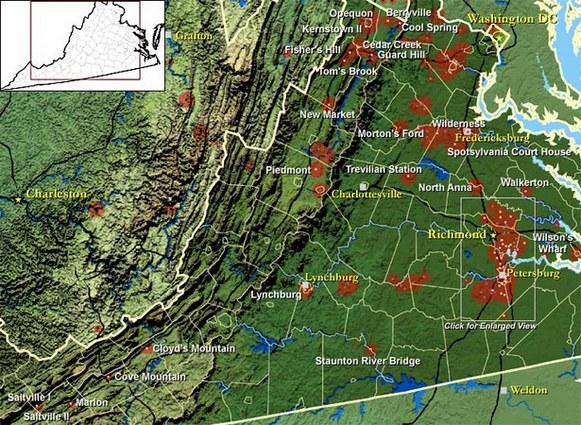
|
| What was the purpose of salt during the Civil War? Life. |
Union Forces
Union Army Order of Battle
Brevet Maj. Gen. Stephen G. Burbridge
Brig. Gen. Edward H. Hobson
• 13th Kentucky Cavalry
•
30th Kentucky Mounted Infantry
• 35th Kentucky Mounted Infantry
• 40th Kentucky Mounted Infantry
•
45th Kentucky Mounted Infantry
Col. Charles Hanson (wounded), Col. Clinton True
• 11th Kentucky
Cavalry
• 26th Kentucky Mounted Infantry
• 37th Kentucky Mounted Infantry
• 39th Kentucky Mounted Infantry
Col. Robert W. Ratliff
• 5th U.S. Colored Cavalry (with parts
of the 6th U.S. Colored Cavalry)
• 11th Michigan Cavalry
• 12th Ohio Cavalry
Confederate Forces
Confederate Army Order of Battle
Brig. Gen. John Echols; Maj. Gen. John C. Breckinridge
Department of Southwest Virginia
Brig. Gen. Alfred E. Jackson
Col. Henry Giltner
• 4th Kentucky Cavalry
• 10th Kentucky
Cavalry Battalion
• 10th Kentucky Mounted Rifles
• 64th Virginia Mounted Rifles
• Two Independent
Companies of Kentucky Cavalry under Captain Barton W. Jenkins and Captain T. W. Barrett
Lt. Col. Robert T. Preston
• 4th (5th) Virginia Reserve Battalion
Lt. Col. Robert Smith
• 13th (6th) Virginia Reserve Battalion
Captain John W. Barr
• Virginia Artillery Battery
Army of Tennessee
Brig. Gen. John S. Williams
Col. William C. P. Breckinridge
• 1st Kentucky Cavalry (one
battalion)
• 9th Kentucky Cavalry
Col. George G. Dibrell
• 4th Tennessee Cavalry
• 8th
Tennessee Cavalry / 13th Tennessee Cavalry
• 9th Tennessee Cavalry
Brig. Gen. Felix H. Robertson
• 3rd Confederate Cavalry (fragment)
•
6th Confederate Cavalry (fragment)
• 8th Confederate Cavalry (one battalion)
• 10th Confederate Cavalry
•
5th Georgia Cavalry (fragment)
• Champ Ferguson's Independent Kentucky and Tennessee Cavalry
| Battle of Saltville Interpretive Marker |
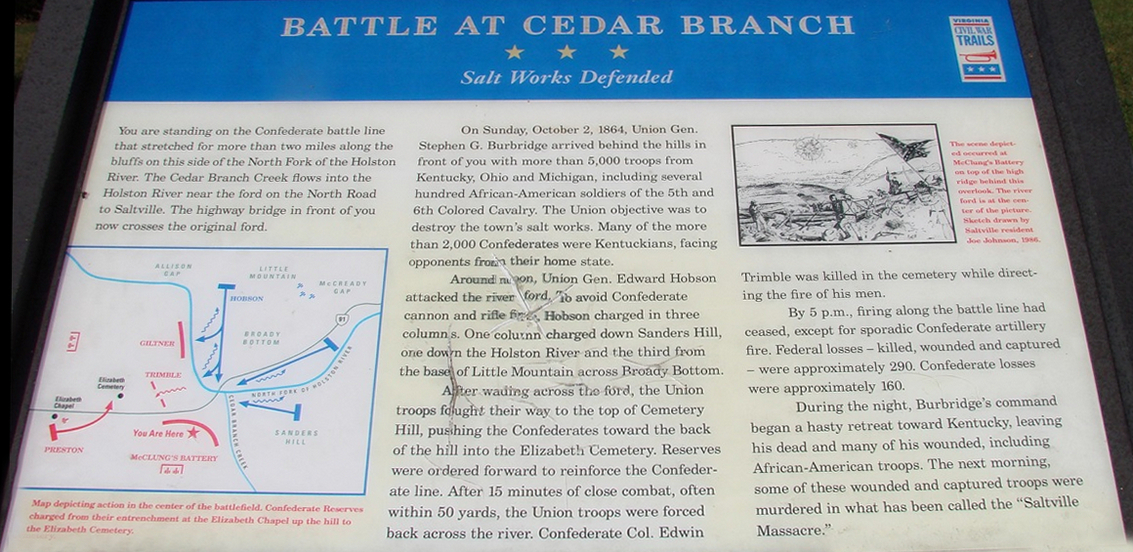
|
| First Battle of Saltville, known locally as Battle of Cedar Branch |
| Battle of Saltville Official Report |
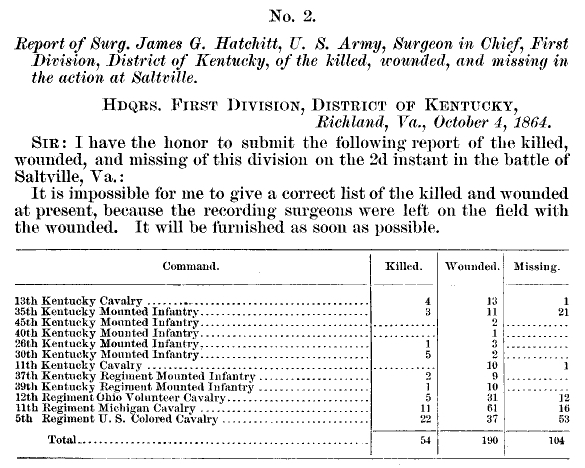
|
| Union Units and Casualties at Battle of Saltville |
Casualties: Cavalry,
unlike the Kentucky mounted units which fought while dismounted at Saltville, were expected to ride and
fight, so to equip even the best crack-shot cavalrymen with muskets was a suicidal endeavor — and the Union
command during the Battle of Saltville knew it. In fairness to the Union Army, it had equipped all its cavalry
units with carbines by 1864, but the 5th was not an organized unit until Oct. 24, 1864. The commander of the 5th, Col.
Brisbin, never complained about using the recruits with Enfields, but with enthusiasm he ordered them forward into
battle.
While the raw and inappropriately armed 5th U.S. Colored Cavalry, would
be ordered to fight while dismounted, they charged headlong into strong Confederate works, then fired their single-shot P53
Enfield muskets, and unable to reload they were mowed down by the experienced foe similar to a sharp sickle slicing through grass.
(Right) Union units and casualties suffered at Battle of Saltville. This
casualty report was compiled by the division's chief surgeon, and it concurs with casualty reports submitted by Brevet Maj.
Gen. Burbridge himself.
The 5th US Colored Cavalry lost 28% of the force it fielded and it suffered 33% of the total Union casualties
at Saltville.
In his after battle reports on Oct. 7 and 10, 1864, Gen. Burbridge stated his losses at 350. Confederate
casualties were stated "as fewer than 100." On Oct. 4, Surgeon James G. Hatchitt, Chief Surgeon, First Division,
District of Kentucky, submitted his casualty report for the respective units involved
in the fight at Saltville. Although Hatchitt stated that the report was not complete because surgeons were still in the field
with the wounded, the numbers would only change as surgeons marked and moved any wounded who died to the killed
category. Hatchitt shows 348 total casualties, with 54 killed, 190 wounded, and 104 missing. His casualty report
includes 112 losses for the 5th U.S. Colored Cavalry: 22 killed, 37 wounded, and 53 missing. Colonel James S. Brisbin,
commanding 5th USCC, wrote in his report, Oct. 20, 1864, that "Out of the 400 engaged 114 men and 4 officers fell killed
or wounded." Brisbin had actually included missing-in-action, wounded, and killed in a simple total for his report, but
Hatchitt, who oversaw attending surgeons in the field, presented categorical losses for the unit.
Captain Guerrant also discussed
the incident in his diary. He noted that he heard the continuous sound of rifle fire which meant the death of, “many
a poor negro who was unfortunate enough not to be killed yesterday.” He wrote that his men did not take any Negro
prisoners, and that great numbers of the African-American soldiers were killed. However, he did not specify any
number of soldiers killed. According to first hand accounts from soldiers of both armies, although no exact count
was given, the total number of black soldiers murdered was less than 50.
On October 3rd, Mosgrove wrote that Colonel Hanson of the Federal army was lying wounded in a field hospital,
having been shot by a minie ball; he was drunk and swearing at the hospital staff. This same hospital is where Mosgrove writes
that while surgeon William H. Gardner was tending the Federal wounded, three armed Confederate soldiers stormed into the hospital
and fatally wounded five African-American soldiers. Mosgrove claims to have witnessed a great deal of slaughtering of
members of the USCC on the fields, primarily by two Tennessee brigades under the command of Gen. Robertson and Colonel Dibrell.
However, Mosgrove never specifies the total number of black soldiers killed during the massacre.
This
battle involved fighting in and around Saltville and also was a running fight while the Union force was retreating.
With the exception of two cavalry regiments, 11th Michigan and 12th Ohio, the Union army consisted of
Kentucky mounted units. The battle included Confederate regulars, reserves, militia, and even guerrillas, which
complicated an exact casualty count, too. The Confederate strength varied during the battle because of the types
of units, such as guerrilla units, which would strike the Union army in and around Saltville and then vacate the area, only
to reappear and unleash subsequent blows. While units were engaged, Confederate troops were still arriving from neighboring East
Tennessee.
| Bullets used by both armies at First Saltville |
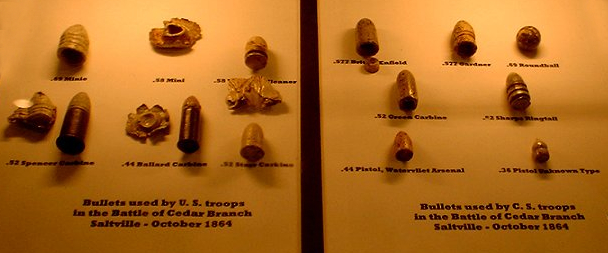
|
| Weapons used by Union and Confederate armies at First Battle of Saltville |
The total losses for the Union command were frustrated for other reasons:
the 5th U.S. Colored Cavalry was green, it was a raw unit from Kentucky that had been thrown together en
route to Saltville. Whereas some men of the unit had yet to enlist, the 5th USCC was not an official Union unit
until it was organized on October 24, which was three weeks after the battle. High casualties for the colored troopers
can partially be attributed to their being inexperienced, but the brunt of the blame must be shouldered by the Union
military for arming the black cavalrymen with Enfield rifle-muskets, while its experienced white cavalry marched
into the fray sporting Spencer carbines capable of firing 14 to 21 rounds per minute. The Enfield had
to be reloaded through the muzzle after each shot, meaning dismounted of course. It also had a lengthy reloading
process that enabled (or restricted) an experienced foot soldier to fire three aimed shots per minute. Once the
black troops fired their single-shot Enfields in the action, they were exposed on the side of the mountain and became easy
targets for the Confederates shooting down from the rifle pits.
Carbines and rapid
firing rifles were adopted by the Union Army for all cavalry units early in the Civil War, unless you were a member of the
5th USCC during the First Battle of Saltville in 1864. Most of the cavalrymen, with the exception of the colored cavalry of
course, also had two or three revolvers at Saltville, which was standard practice by both Union and Confederate cavalries
by 1864. Another disparity, not that it would have made a difference to the untrained colored cavalry or any cavalryman, that
day, was the fact that while the single-shot muzzle-loading Enfield had an effective range of 300 plus yards,
the Spencer repeating rifle could reach out and touch the enemy at an effective range of more than 500 yards, but the Spencer
carbine, because of its shorter barrel, had an effective range of 150-200 yards. (See also Civil War Weapons, Small Arms, Firearms,
and Edged Weapons and Civil War Weapons, Firearms, and Small Arms,)
Analysis: The Battle of Saltville began around 11 a.m., Sunday, October 2, and lasted until 5
p.m. Arriving just earlier that morning at 9:30 with 1,700 men, Confederate Brig. Gen. John S. Williams commanded Saltville's
2,800 defenders during the fight. Williams and the other Southern field commanders handled their troops well for the six hours
of the battle; conversely, Burbridge led his troops rather poorly. The Confederates commanded the heights and did terrible
damage with their long-range Enfields firing downhill at the struggling Federals (Davis, 1971). Davis (1971, p. 11) describes
an almost mirthful attitude among the Southerners, some shouting after a volley "Come right up and draw your salt." One soldier,
after firing at a bluecoat, yelled "How's that? Am I shooting too high or too low?" By 5 p.m., Burbridge knew he was beaten
and withdrew. Thanks to their excellent defensive positions, the Confederates lost fewer than a hundred killed and wounded;
Burbridge reported a total of 350, most of them left behind on the field (Davis, 1971). The Battle of Saltville was a clear
Southern victory that kept the saltworks safe for another few months. As Davis (1971, p. 48) points out, it could have led
to more significant things but the Confederacy was too weak to exploit the victory. One historical note of great interest
to Civil War scholars concerning this engagement is the intensely debated "Saltville Massacre" (Davis, 1993). According to
some (Davis, 1971), rebel soldiers, after the battle, shot many wounded Union troops, especially African-Americans, lying
helpless on the battlefield; other Federals were murdered some days later in the Confederate hospital set up at nearby Emory
and Henry College. Marvel (1991, 1992) vigorously disputes this and refers to the alleged massacre as a "legend." The interested
reader is directed to these sources for detailed accounts.
Although General Sun Tzu lived more than two millennia ago, his Chinese military treatise, The Art of
War, continues to influence military minds the world over. Tzu says that "Strategy without tactics
is the slowest route to victory. Tactics without strategy is the noise before defeat."
The principles of Sun Tzu's The Art of War are currently taught at elite schools such
as West Point, Navy Academy, US Army War College, and Air Force Academy. While both sides at
Saltville failed to fully implement Tzu's principles, Burbridge made numerous crucial mistakes that led to his defeat.
To paraphrase Sun Tzu, when you have the advantage press it, but Burbridge rested his large army the day before and just some
miles prior to the 400 Confederates that awaited him, thus allowing the enemy precious time needed to swell his ranks
to 2,800 on the high ground.
Tzu states that you should not attack an enemy at his strongpoint; don't attack when and where your
enemy expects it; and never press the fight when you are low on supplies. Burbridge committed all these mistakes. The
Confederate leadership, mainly Williams, according to Tzu, applied many of The Art of War principles by first
hitting the enemy when and where he least expects it, meaning East Tennessee; by delaying the enemy and enlarging
his force for the imminent fight; by allowing the enemy to believe that the army remains smaller; and by applying
treacherous terrain to an advantage and then luring the opponent into attacking. While Breckinridge failed on the next
tactic, Burbridge succeeded, however. To completely destroy your enemy you must eliminate his route of escape.
Brig. Gen. John S. Williams
summed up the fight in one sentence: "We whipped the enemy badly." Although a decisive Confederate victory,
Union forces would subdue the saltworks in two months on December 21, 1864, during the Second Battle of Saltville.
Of note was the raw, untrained 5th U.S. Colored Cavalry that was thrown together en route to the First Battle of Saltville.
The 5th USCC had its ranks filled with men who had not yet enlisted, and while the 5th
fought heroically, it would not be an official unit until three weeks after the battle when it formed on October
24, 1864. The men of the 5th USCC, numbering 400 effectives at Saltville,
fought on par with any white soldier, according to several battle reports from Union officers.
The Union assault up a steep hill and directly into the stout Confederate
front was suicidal, and without sufficient reserves, Burbridge would force the action only to blame others for his failure
to achieve a victory. The Union general was quick to take credit for his past victories, but at Saltville he had many
excuses for the debacle, some rather outlandish. Burbridge would give a myriad of excuse for his failed attempt at Saltville,
hoping that at least some of them would stick.
Bvt. Maj. Gen. Burbridge opened his report to headquarters by stating that he had whipped the Rebels
in every engagement in Virginia. He said that the only thing that prevented him from
entering the works was lack of ammunition, but then said the failure was also because Gen. Gillem did not come
to his aid. He wrote that he could only put into action 2,500 men, but that the enemy greatly outnumbered him by placing
as many as 10,000 on the field, or that he could have taken the works. Our loss was 350, but it is certain the enemy
lost many more, continued Burbridge.
His following statement in the Official Records was false. We held the works for hours, said Burbridge,
but I withdrew the command in excellent order and spirits, and nearly all the wounded colored soldiers were brought off the
mountain. If that was the case, then the more than 200 wounded and missing left on the field, many African-Americans, would
not have fallen into the hands of an angry enemy that would later be accused of murdering many of them.
| Saltville, Virginia, Civil War |
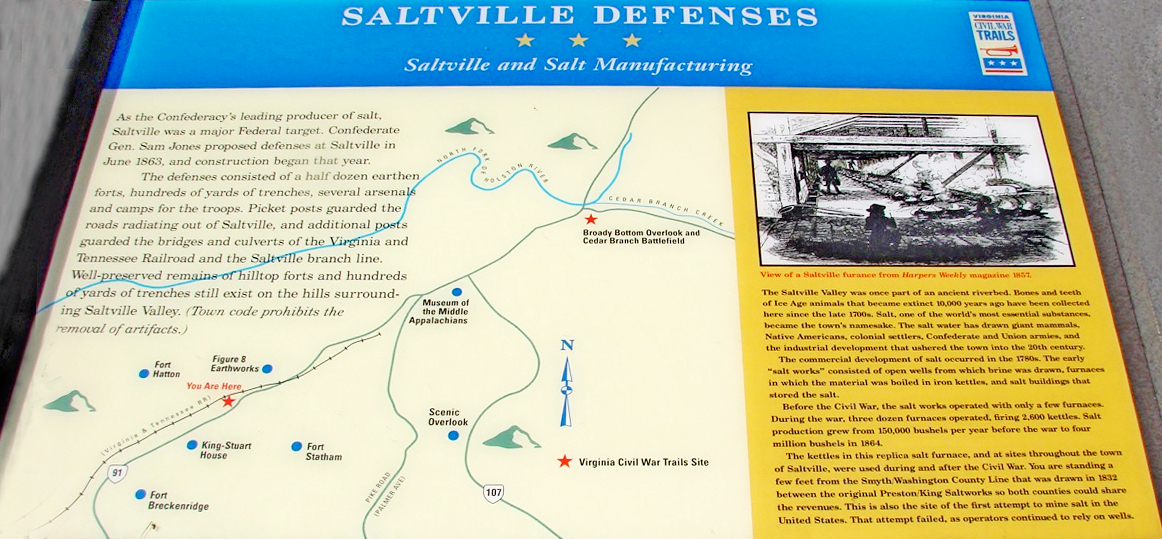
|
| Ring of Defenses at Saltville |
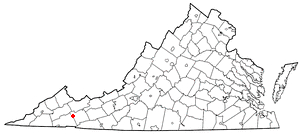
|
| Saltville shaded in red |
Saltville: Salt
played a major role during the Civil War. Salt not only preserved food in the days before refrigeration, but was also vital
in the curing of leather. Union Gen. William Tecumseh Sherman once said that "salt is eminently contraband," as an
army that has salt can adequately feed its men.
The most important saltworks of the Confederacy made Saltville,
Virginia, contested real estate for both armies. In 1864, the works manufactured about 4,000,000 bushels (200,000,000
pounds) of salt, roughly one-third of the said mineral required by the Confederacy. In the same year, the Union army
twice advanced to capture and lay waste to the saltworks, as it was the last prominent source of salt for most of
the Confederate states. The First Battle of Saltville, October 1864, saw the Confederates repulse the disorganized Union
attack led by Bvt. Maj. Gen. Burbridge, but a few months later during the Second Action of Saltville in December, Federal
forces under Maj. Gen. Stoneman would lay waste to much of the vital works. Two months later in February, however, the
saltworks were at near full production for the Confederacy, but for want of tracks in the area, trains were unable
to haul the capacity needed to sustain a viable fighting force in the field.
In Georgia, the price of salt depended on one's family circumstances. Heads
of families could purchase a half-bushel of salt for $2.50. If a widow had a son in the Confederate army, the price was only
$1.00. But if the widow's husband served his nation, the price was free. Local court clerks sent the salt requests to the
state government, which in turn allotted the salt to the counties as requested.
Some scholars contend that Florida's greatest contribution to the Confederate
war effort was in producing salt. With a total investment of $10 million, Floridian salt plants worked 24 hours a day boiling
salt from sea water, mostly in the area between Saint Andrews Bay and St. Marks, Florida. Occasionally, Union forces came
ashore just to destroy the boilers. Confederate law made those involved in salt-making immune to being drafted, making it
a popular profession in war-time Florida; the estimated total workers involved was 5,000.
One way Southern families acquired salt was to boil the dirt in areas where
they had previously cured meats. They would dig it out, and strain it.
Avery Island, off the Louisiana coast, gave the Confederacy a huge supply
of rock salt until the Union captured it. However, Confederates never realized that similar structures to the rock salt mine
were all along the Louisiana and Texas coasts of the Gulf of Mexico, and therefore salt could have been more easily attained
if they had but realized it.
(Sources and related reading are listed below.)
Recommended Reading: Saltville
(VA) (Images of America), by Jeffrey C. Weaver (Author), The Museum of the Middle Appalachians (Author): Description:
Saltville, Virginia, lies on the banks of the North Fork of the Holston River on the border between Smyth and Washington Counties.
Its history began very long ago; in fact, archeological evidence suggests extensive human habitation there for more than 14,000
years. Saltville was named because it was a source of salt,-and by the end of the 18th century, a thriving industry was born.
During the Civil War, Saltville attained considerable importance to the Confederate government as a supply of salt. Continued
below…
A large Confederate
army garrison was maintained there, and extensive fortifications were constructed. After the Civil War, the town led the way
in industrialization of the South. Flip through the pages of Images of America: Saltville to learn why Saltville is one of
the most historic places in the world. About the Author: The Museum of the Middle Appalachians, located on Palmer Avenue
in Saltville, was established by the Saltville Foundation in the 1990s. It has become the repository for fossils, artifacts,
and photographs of the region. Author Jeffrey C. Weaver holds degrees in American history from Appalachian State University,
and after serving in the U.S. Army for several years, he worked as a contracting officer for the U.S. Department of Energy.
He is currently the manager of the Chilhowie Public Library.
Recommended
Reading: Saltville Massacre (Civil War Campaigns
and Commanders). Description: In October 1864, in the mountains of southwest Virginia,
one of the most brutal acts of the Civil War occurs. Brig. Gen. Stephen Burbridge launches a raid to capture Saltville. Included
among his forces is the 5th U.S. Colored Cavalry. Repeated Federal attacks are repulsed by Confederate forces under the command
of Gen. John S. Williams. Continued below…
As the sun
begins to set, Burbridge pulls his troops from the field, leaving many wounded. In the morning, Confederate troops, including
a company of ruffians under the command of Captain Champ Ferguson, advance over the battleground seeking out and killing the
wounded black soldiers. What starts as a small but intense mountain battle degenerates into a no-quarter, racial massacre.
A detailed account from eyewitness reports of the most blatant battlefield atrocity of the war.
Recommended
Reading: Lee's Endangered Left: The Civil War In Western Virginia, Spring Of 1864. From Kirkus Reviews: A competent, well-executed addition to the
ever-growing horde of Civil War literature, by Duncan (History/Georgetown University). The author reconsiders Union General
Ulysses S. Grants attempts to destroy the Confederates, led by General Robert E. Lee, at their traditional stronghold in western
Virginia and his efforts to threaten Lynchburg
during the spring and summer of 1864. Continued below…
The writing
here is crisp; refreshingly, our chronicler pays sharp attention to the effects of the campaign on civilians as the Union
army penetrated beyond its supply lines and came to live off the countryside in one of the Confederacy’s richest agricultural
regions, bringing home the harsh realities of war to civilians. The campaign swung back and forth, with Northern victories
at Cloyd's Mountain and New
River Bridge and Confederate routs at New Market, followed by a Union
failure to seize Lynchburg. Though the campaign proved costly
to the South, overall the Unions hope to capture the Shenandoah Valley foundered and the Confederates then went on to threaten
Washington, D.C. Duncan sensitively employs a wide variety of sources, military and civilian, to add to the coherence of his
account. Still, the books scope remains narrow, focusing on a not terribly glamorous period in the wars history; then, too,
wed do well to have the volume trimmed by a third. Duncan’s contention that the Unions
severity in dealing with civilian populations was directly reciprocated when the Confederates took Chambersburg,
Penn., creating a chain of vengeance that culminated when Sherman marched through the South, is insightfully argued, offering a fresh analysis to the
historical debate. Casual readers of the Civil War genre (and many die-hard buffs, as well) may want to leave this superbly
researched yet ultimately too specialized study for the historians to ponder. Includes 20 photographs.
Recommended
Reading: Stonewall in the Valley: Thomas J. Stonewall Jackson's Shenandoah Valley Campaign,
Spring 1862. Description: The Valley Campaign
conducted by Maj. Gen. Thomas J. "Stonewall" Jackson has long fascinated those interested in the American Civil War as well
as general students of military history, all of whom still question exactly what Jackson
did in the Shenandoah in 1862 and how he did it. Since Robert G. Tanner answered many questions in the first edition of Stonewall
in the Valley in 1976, he has continued to research the campaign. This edition offers new insights on the most significant
moments of Stonewall's Shenandoah triumph. Continued below…
About the Author:
Robert G. Tanner is a graduate of the Virginia Military Institute. Tanner is a native of Southern California, he now lives
and practices law in Atlanta, Georgia. He has studied and lectured
on the Shenandoah Valley Campaign for more than twenty-five years.
Recommended
Reading: Shenandoah 1862: Stonewall Jackson's Valley Campaign, by Peter Cozzens (Civil War America) (Hardcover). Description: In the spring of 1862, Federal troops under
the command of General George B. McClellan launched what was to be a coordinated, two-pronged attack on Richmond in the hope of taking the Confederate capital and bringing a quick end to the Civil
War. The Confederate high command tasked Stonewall Jackson with diverting critical Union resources from this drive, a mission
Jackson fulfilled by repeatedly defeating much larger enemy forces. His victories elevated him to near iconic status in both
the North and the South and signaled a long war ahead. One of the most intriguing and storied episodes of the Civil War, the
Valley Campaign has heretofore only been related from the Confederate point of view. Continued below…
With Shenandoah
1862, Peter Cozzens dramatically and conclusively corrects this shortcoming, giving equal attention to both Union and Confederate perspectives.
Based on a multitude of primary sources, Cozzens's groundbreaking work offers new interpretations of the campaign and the
reasons for Jackson's success. Cozzens also demonstrates instances
in which the mythology that has come to shroud the campaign has masked errors on Jackson's
part. In addition, Shenandoah 1862 provides the first detailed appraisal of Union leadership in the Valley Campaign, with
some surprising conclusions. Moving seamlessly between tactical details and analysis of strategic significance, Cozzens presents
the first balanced, comprehensive account of a campaign that has long been romanticized but never fully understood. Includes
13 illustrations and 13 maps. About the Author: Peter Cozzens is an independent scholar and Foreign Service officer with the
U.S. Department of State. He is author or editor of nine highly acclaimed Civil War books, including The Darkest Days of the
War: The Battles of Iuka and Corinth (from the University
of North Carolina Press).
Recommended
Reading: Shenandoah Summer: The 1864 Valley Campaign. Description: Jubal A. Early’s disastrous battles in the Shenandoah Valley
ultimately resulted in his ignominious dismissal. But Early’s lesser-known summer campaign of 1864, between his raid
on Washington and Phil Sheridan’s renowned fall campaign, had a significant impact on the political and military landscape
of the time. By focusing on military tactics and battle history in uncovering the facts and events of these little-understood
battles, Scott C. Patchan offers a new perspective on Early’s contributions to the Confederate war effort—and
to Union battle plans and politicking. Patchan details the previously unexplored battles at Rutherford’s Farm and Kernstown
(a pinnacle of Confederate operations in the Shenandoah Valley) and examines the campaign’s
influence on President Lincoln’s reelection efforts. Continued below…
He also provides
insights into the personalities, careers, and roles in Shenandoah of Confederate General John C. Breckinridge, Union general
George Crook, and Union colonel James A. Mulligan, with his “fighting Irish” brigade from Chicago.
Finally, Patchan reconsiders the ever-colorful and controversial Early himself, whose importance in the Confederate military
pantheon this book at last makes clear. About the Author: Scott C. Patchan, a Civil War battlefield guide and historian, is
the author of Forgotten Fury: The Battle of Piedmont, Virginia, and a consultant and contributing writer for Shenandoah, 1862.
Review
"The author's
descriptions of the battles are very detailed, full or regimental level actions, and individual incidents. He bases the accounts
on commendable research in manuscript collections, newspapers, published memoirs and regimental histories, and secondary works.
The words of the participants, quoted often by the author, give the narrative an immediacy. . . . A very creditable account
of a neglected period."-Jeffry D. Wert, Civil War News (Jeffry D. Wert Civil War News 20070914)
"[Shenandoah
Summer] contains excellent diagrams and maps of every battle and is recommended reading for those who have a passion for books
on the Civil War."-Waterline (Waterline 20070831)
"The narrative
is interesting and readable, with chapters of a digestible length covering many of the battles of the campaign."-Curled Up
With a Good Book (Curled Up With a Good Book 20060815)
"Shenandoah
Summer provides readers with detailed combat action, colorful character portrayals, and sound strategic analysis. Patchan''s
book succeeds in reminding readers that there is still plenty to write about when it comes to the American Civil War."-John
Deppen, Blue & Grey Magazine (John Deppen Blue & Grey Magazine 20060508)
"Scott C. Patchan
has solidified his position as the leading authority of the 1864 Shenandoah Valley Campaign with his outstanding campaign
study, Shenandoah Summer. Mr. Patchan not only unearths this vital portion of the campaign, he has brought it back to life
with a crisp and suspenseful narrative. His impeccable scholarship, confident analyses, spellbinding battle scenes, and wonderful
character portraits will captivate even the most demanding readers. Shenandoah Summer is a must read for the Civil War aficionado
as well as for students and scholars of American military history."-Gary Ecelbarger, author of "We Are in for It!": The First
Battle of Kernstown, March 23, 1862 (Gary Ecelbarger 20060903)
"Scott Patchan
has given us a definitive account of the 1864 Valley Campaign. In clear prose and vivid detail, he weaves a spellbinding narrative
that bristles with detail but never loses sight of the big picture. This is a campaign narrative of the first order."-Gordon
C. Rhea, author of The Battle of the Wilderness: May 5-6, 1864 (Gordon C. Rhea )
"[Scott Patchan]
is a `boots-on-the-ground' historian, who works not just in archives but also in the sun and the rain and tall grass. Patchan's
mastery of the topography and the battlefields of the Valley is what sets him apart and, together with his deep research,
gives his analysis of the campaign an unimpeachable authority."-William J. Miller, author of Mapping for Stonewall and Great
Maps of the Civil War (William J. Miller)
Sources: National Park Service; Official Records of the Union and Confederate
Armies; Library of Congress; National Archives; Jonathan Sutherland. African Americans at War: An Encyclopedia, Volume 1;
Blue & Gray Magazine, Volumes 17-18. Blue & Gray Enterprises,
1999; Scott C. Patchan. Shenandoah Summer: The 1864 Valley Campaign, 2009;
Richard R. Duncan. Lee's Endangered Left: The Civil War In Western Virginia, Spring Of 1864 (Hardcover), 1999; Thomas D. Mays.
Saltville Massacre, 1998; Jeffrey C. Weaver. Saltville (VA) (Images of America), 2006; Bryan S. Bush. Butcher Burbridge: Union
General Stephen Burbridge and His Reign of Terror Over Kentucky, 2008; Graham MacGregor. Salt, Diet and Health. Cambridge
University Press, 1998; Frances Kennedy. The Civil War Battlefield Guide, 1998; David Heidler. Encyclopedia Of The American
Civil War; Angela M. Dautartas, C. Clifford Boyd, Rhett B. Herman, Robert C. Whisonant. Battles of Saltville: October 2nd,
1864 and December 20th, 1864 (2005); Virginia Department of Mines, Minerals and Energy, dmme.virginia.gov; Missouri University
of Science and Technology, mst.edu; Oakland City University, oak.edu.
|

